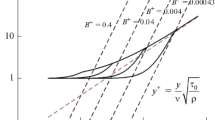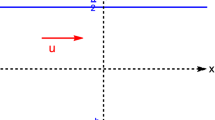Abstract
The dissipation theorem is applied to fully developed turbulent flow past a flat plate. Most of the velocity profile occurs in a thin layer near the surface, but a layer of turbulence (represented by the eddy viscosity) extends substantially farther into the fluid.










Similar content being viewed by others
REFERENCES
Newman, J., New perspectives on turbulence, Russ. J. Elecrochem., 2020, vol. 56, p. 795. https://doi.org/10.1134/S1023193520100092
Newman, J., The fundamental principles of current distribution and mass transport in electrochemical cells, in Electroanalytical Chemistry, Bard, A.J., Ed., New York: Marcel Dekker, 1973, vol. 6, pp. 187–352.
Schlichting, H., Boundary-Layer Theory, New York: McGraw-Hill Book Co., 1979.
Heisenberg, W., On Stability and Turbulence of Fluid Flows, Washington: National Advisory Committee on Aeronautics, 1951, technical memorandum no. 1291. Translation of “Über Stabilität und Turbulenz von Flüssigkeitssströmen,” Ann. Phys., 1924, vol. 74, no. 15, pp. 577–627.
Murphree, E.V., Relation between heat transfer and fluid friction, Ind. Eng. Chem., 1932, vol. 24, p. 726. https://doi.org/10.1021/ie50271a004
Levich, B., The theory of concentration polarization, I, Acta Physicochim. URSS, 1942, vol. 17, p. 257.
Levich, B., The theory of concentration polarization, II, Acta Physicochim.URSS, 1944, vol. 19, p. 117.
Newman, J. and Balsara, N.P., Electrochemical Systems, Hoboken, NJ, 2021.
Nikuradse, J., Gesetzmässigkeitem der turbulentem Strömung in glatten Rohren, in Forschungsheft 356, Beilage zu Forschung auf dem Gebiete des Ingenieurwesens, Berlin: VDI-Verlag GMBH, 1932, ed. B, vol. 3. Translated as Nikuradse, J., Laws of turbulent flow in smooth pipes, NASA TT F-10, 359, Washington: National Aeronautics and Space Administration, Oct. 1966.
Newman, J., Further thoughts on turbulent flow in a pipe, Russ. J. Elecrochem., 2019, vol. 55, p. 34. https://doi.org/10.1134/S1023193519010105
Author information
Authors and Affiliations
Corresponding author
Ethics declarations
The author declares that he has no conflict of interest.
APPENDIX A
APPENDIX A
DECAY OF DISSIPATION
We need to ascertain exactly what form was used for the dimensional Decay in pipe flow because we need to know what to use in other geometries and also to tell others what we are doing.
The central idea behind the dissipation theorem is that turbulence should be described by several mathematical relationships among local statistical quantities, particularly the total stress, the eddy viscosity, and the volumetric dissipation. Hence, the dissipation theorem describes how the volumetric dissipation \({{\mathcal{D}}_{V}}\) changes with time, convection, diffusion, and decay:
where \({\mathbf{\bar {v}}}\) is the average velocity, diffusion is described by the kinematic viscosity ν and the eddy kinematic viscosity ν(t), and Decay is the dimensional decay. This equation attempts to show the vector nature of the quantities. However, ν(t) is really a tensor which is approximated as a scalar in certain systems of turbulent shear.
For steady turbulent flow in a cylindrical pipe, this equation becomes
Diffusion in the longitudinal direction is neglected, and only one component of the tensor eddy viscosity is needed.
Dimensionless variables are chosen as follows:
the last being chosen so that Dp = 1 on the wall of the pipe. (The subscript p on Dp is to distinguish Dp from D used with flow past a flat plate.) R is the radius of the pipe, and τ0 is the magnitude of the stress at the wall of the pipe. Substitution gives
One can say that τ0/R = τ/r for this geometry, so that τ is a local variable. For turbulent pipe flow, the dimensional Decay and the dimensionless decayp are related as shown in equation (A4).
By reverse engineering of Nikuradse’s data, we find that decay depends mainly on R+Dp/ξ, with both a quadratic and a linear term. We write this as
(There are also a term DpR+ and a 4, which can perhaps be ignored.) Thus, Decay becomes
Preferred values are Λ = 0.17 and ε = 0.33. (Earlier ε was used with a different meaning, including a dependence on R+.) In addition, the viscous sublayer is grafted in with a value of B+ = 0.0005. [If the wall stress τ0 can be taken to be known, the problem becomes more like the problems with the pipe and the rotating cylinders.]
The scaling for the flat plate is different from that for the pipe. R and τ0 are nonlocal variables. For the flat plate, equation 1 and
apply. Thus
where \({{v}_{*}}\) = (τ0/ρ)0.5.
The dissipation-theorem equation takes the form
or
This becomes
After the similarity transformation, the dissipation theorem equation becomes (see equation (6))
We still need to decide what various symbols, such as τ0/ρ\(v_{\infty }^{2}\) and \({{v}_{*}}\)ν/R\(v_{\infty }^{2}\), mean in the context of flow past a flat plate. The form actually used in the computer program in equation (25) is
Rights and permissions
About this article
Cite this article
John Newman Turbulent Flow past a Flat Plate at Zero Incidence. Russ J Electrochem 57, 743–756 (2021). https://doi.org/10.1134/S1023193521070090
Received:
Revised:
Accepted:
Published:
Issue Date:
DOI: https://doi.org/10.1134/S1023193521070090




